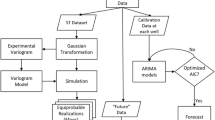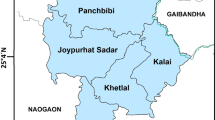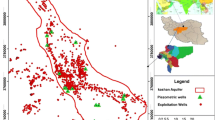Abstract
Analysis of the characteristics and propagation behaviors of groundwater drought at different aquifer sites during past and future periods needs a proper understanding regarding its relation with meteorological droughts. Use of a robust technique of modeling (stochastic models) allowed groundwater level and precipitation to be forecasted and then the droughts were computed and analyzed using Standardized Precipitation Index (SPI). In this research, Aleshtar Plain was selected as a case study. Analysis in this region was carried out by hierarchy and K-means clustering (5 clusters), because of the regional investigation of groundwater drought and large number of boreholes. The performance results of models showed that best forecasting models in cluster 1, 2, 3, 4 and 5 were Auto-Regressive (AR)(1), AR(2), Moving Average (MA)(2), Mixed Autoregressive–Moving Average (ARMA)(2,2) and AR(2), respectively. Furthermore, the most appropriate model for precipitation within the study plain was ARMA(1, 2). Investigation of the relationship between meteorological and groundwater drought indicated that the strongest correlation between two types of droughts was for clusters 4 and 1 with a correlation coefficient of 0.76 and 0.63, respectively. Also, the lowest correlation was for cluster 2 with a correlation coefficient of 0.51. The results of cumulative periods related to the maximum correlation between SPI and Standardized Groundwater Level Index (SGI) showed that clusters 1 to 3 corresponded with cumulative 24-month periods of SPI and this magnitude for clusters 4 and 5 were 18 and 12 months, respectively. Moreover, results of maximum drought severity showed there was low variability between clusters considering the extreme droughts (SGI ≤ −2) during the study period. For the future period, drought severity results showed that groundwater drought of 2019 may happen with moderate value in cluster 5, severe values in clusters 2, 1 and 4, respectively, and extreme value in cluster 3. Hydrogeological evidence of the sites and results of autocorrelation structure of SGI series confirmed the time taken by meteorological drought for propagation into groundwater. Furthermore, results showed that the aquifer is controlled more by hydraulic diffusivity factor. so it would be expected that drought propagation time into groundwater would be long for the Western part and relatively short for sites located in the East, South tending to center and partially north of the aquifer. In general, these results represent an early warning system for groundwater drought preparation and mitigation of its impacts in a future time.




Similar content being viewed by others
References
Aguilera PA, Fernandez A, Ropero RF, Molina L (2013) Groundwater quality assessment using data clustering based on hybrid Bayesian networks. Stoch Env Res Risk A 27:435–447
Akaike H (1974) A new look at the statistical model identification. IEEE Trans Autom Control AC-19:716–723
Anderson MP, Woessner WW, Hunt RJ (2015) Applied groundwater modeling: simulation of flow and advective transport. 2nd edition, Elsevier press. 563 pp.
Aviles A, Celleri R, Paredes J, Solera A (2015) Evaluation of Markov chain based drought forecasts in an Andean regulated River Basin using the skill scores RPS and GMSS. Water Resour Manag 29:1949–1963
Barker LJ, Hannaford J, Chiverton A, Svensson C (2015) From meteorological to hydrological drought using standardized indicators. Hydrol Earth Syst Sci 12:12827–12875
Barlow PM, Leake SA (2012) Streamflow depletion by wells—Understanding and managing the effects of groundwater pumping on streamflow: U.S. Geological Survey Circular 1376, 84 p. Also available at http://pubs.usgs.gov/circ/1376/
Bidwell VJ (2005) Realistic forecasting of groundwater level, based on the Eigen structure of aquifer dynamics. Math Comput Simul 69:12–20
Bloomfield JP, Marchant BP (2013) Analysis of groundwater drought building on the standardized precipitation index approach. Hydrol Earth Syst Sci 17:4769–4787
Bloomfield JP, Marchant BP, Bricker SH, Morgan RB (2015) Regional analysis of groundwater droughts using hydrograph classification. Nat Hazards Earth Syst Sci 19:4327–4344
Box GEP, Jenkins GM, Reinsel GC (2005) Time series analysis: forecasting and control, 3rd edn. Post and Telecommuncations Press, Beijing, 327 pp
Box GEP, Jenkins GM, Reinsel GC, Ljung GM (2016) Time series analysis: forecasting and control, 5th edn. Wiley Press, New Jersey, 669 pp
Daneshmand F, Karimi A, Nikoo MR, Bazargan-Lari MR, Adamowski J (2014) Mitigating socio-economic-environmental impacts during drought periods by optimizing the conjunctive management of water resources. Water Resour Manag 28(6):1517–1529
Dastorani M, Mirzavand M, Dastorani MT, Sadatinejad SJ (2016) Comparative study among different time series models applied to monthly precipitation forecasting in semi-arid climate condition. Nat Hazards Earth Syst Sci 81:1811–1827
De Stefano L, Urquijo J, Kampragkou E, Assimacopoulos D (2015) Lessons learnt from the analysis of past drought management practices in selected European regions: experience to guide future policies. Eur Water 49:107–117
Djerbouai S, Souag Gamane D (2016) Drought forecasting using neural networks, wavelet neural networks, and stochastic models: case of the Algerois Basin in North Algeria. Water Resour Manag 30:2445–2464. doi:10.1007/s11269-016-1298-6
Dutta D, Wendy D, Welsh JV, Shaun SHK, Nicholls D (2012) A comparative evaluation of short-term stream flow forecasting using time series analysis and precipitation-runoff models in water source. Water Resour Manag 26:4397–4415. doi:10.1007/s11269-012-0151-9
Fiorillo F, Doglioni A (2010) The relation between karst spring discharge and rainfall by cross-correlation analysis (Campania, southern Italy). Hydrogeol J 18:1881–1895
Fiorillo F, Guadagno FML (2012) Karst spring discharge time series and drought occurrence in Southern Italy. Environ Earth Sci 65:2273–2283
Han P, Wang PX, Zhang SY, Zhu DH (2010) Drought forecasting based on the remote sensing data using ARIMA models. Math Comput Model 51:1398–1403
Hashmi MZ, Shamseldin AY, Melville BW (2011) Statistical downscaling of watershed precipitation using gene expression programming (GEP). Environ Model Softw 26:1639–1646
Heinrich G, Gobiet A (2012) The future of dry and wet spells in Europe: a comprehensive study based on the ENSEMBLES regional climate models. Int J Climatol 32:1951–1970
Karamouz M, Araghinejad S (2010) Ddvanced hydrology. Amirkabir University Press, Tehran
Lafare AEA, Peach DW, Hughes AG (2016) Use of seasonal trend decomposition to understand groundwater behaviour in the Permo-Triassic Sandstone aquifer, Eden Valley, UK. Hydrogeol J 24:141–158
McKee TB, Doesken NJ, Kleist J (1993) The relationship of drought frequency and duration to time scales. In: Proc. 8th Conf. on Applied Climatology, 17–22 January, Americ Meteorol Soc, Mass, pp 179–184
Mendicino G, Senatore A, Versace P (2008) A groundwater resource index (GRI) for drought monitoring and forecasting in a Mediterranean climate. J Hydrol 357:282–302. doi:10.1016/j.jhydrol.2008.05.005
Mirzavand M, Ghazavi R (2015) A stochastic modelling technique for groundwater level forecasting in an arid environment using time series methods. Water Resour Manag. doi:10.1007/s11269-014-0875-9
Mishra AK, Desai VR (2005) Drought forecasting using stochastic models. Stoch Env Res Risk A 19(5):326–339
Mishra AK, Singh VP (2010) A review of drought concepts. J Hydrol 391:202–216
Naderianfar M, Ansari H (2011) Assessment the effects of drought severity in different time scale on water level fluctuations (Case Study: Nayshabur Plain). Iran J water Resour Eng 4:1–16
Nalbantis I, Tsakiris G (2009) Assessment of hydrological drought revisited. Water Resour Manag 23(5):881–897
Pahl-Wostl C (2007) Transitions towards adaptive management of water facing climate and global change. Water Resour Manag 21(1):49–62
Pervez MS, Henebry M (2014) Projections of the Ganges–Brahmaputra precipitation-downscaled from GCM predictors. J Hydrol 517:120–134
Rezaeianzadeh M, Stein A, Peter CJ (2016) Drought forecasting using Markov chain model and artificial neural networks. Water Resour Manag 30:2245–2259
Shahid S, Hazarika MK (2010) Groundwater droughts in the northwestern districts of Bangladesh. Water Resour Manag 24(10):1989–2006. doi:10.1007/s11269-009-9534-y
Soleimani Motlagh M (2012) Optimized exploitation management of groundwater resources in drought conditions using MODFLOW Model (Case Study: Aleshtar Plain, Lorestan Province). Dessertation, University of Yazd
Thomas T, Jaiswal RK, Nayak PC, Ghosh NC (2014) Comprehensive evaluation of the changing drought characteristics in Bundelkhand region of Central India. Meteorog Atmos Phys. doi:10.1007/s00703-014-0361-1
Tsakiris G (2015) The status of the European waters in 2015: a review. Environ Process 2(3):543–557
Tsakiris G, Nalbantis I, Vangelis H, Verbeiren B, Huysmans M, Tychon B, Jacquemin I, Canters F, Vanderhaegen S, Engelen G, Poelmans L, De Becker P, Batelaan O (2014) A system-based paradigm of drought analysis for operational management. Water Resour Manag 27:5281–5297
Van Lanen, HAJ (2005) On the definition of groundwater drought. In: Abstract of European geosciences union general assembly, Vienna, 24–29
Vicente-Serrano SM, Begueria S, Lopez-Moreno JI, Angulo M, El Kenawy A (2010) A New global 0.5° gridded dataset (1901–2006) of a multiscalar drought index: comparison with current drought index datasets based on the palmer drought severity index. J Hydrometeorol 11:1033–1043
Vicente-Serrano SM, Chura O, Lopez-Moreno JI, Azorin-Molina C (2014) Spatio-temporal variability of droughts in Bolivia: 1955–2012. Int J Climatol 35(10):3024–3040
Wu TN, Lee JY, Huang ChH (2010) Application of time series analysis on temporal variation of fluoride in groundwater around Southern Taiwan Science Park. 7th International conference on fuzzy systems and knowledge discovery (FSKD), Yantai, China, August 10:12, 201
Zare Chahuki MA (2010) Data analysis in natural resources research using SPSS software. Academic, Tehran
Author information
Authors and Affiliations
Corresponding author
Rights and permissions
About this article
Cite this article
Soleimani Motlagh, M., Ghasemieh, H., Talebi, A. et al. Identification and Analysis of Drought Propagation of Groundwater During Past and Future Periods. Water Resour Manage 31, 109–125 (2017). https://doi.org/10.1007/s11269-016-1513-5
Received:
Accepted:
Published:
Issue Date:
DOI: https://doi.org/10.1007/s11269-016-1513-5




